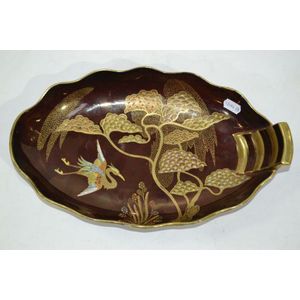French Art Nouveau Cameo Glass Vase
Lovely French Art Nouveau cameo glass vase, of tapering ovoid form, carved with a continuous frieze of flowers and foliage in tones of purple and brown on a yellow and orange ground with silver flecking, height 12.5 cm
You must be a subscriber, and be logged in to view price and dealer details.
Subscribe Now to view actual auction price for this item
When you subscribe, you have the option of setting the currency in which to display prices to $Au, $US, $NZ or Stg.
This item has been sold, and the description, image and price are for reference purposes only.
- Frieze - An architectural term denoting the flat, shaped or convex horizontal surface of furniture, between the architrave and the cornice, usually found on a cabinet or bookcase, or on desks and tables where it may include drawers, the area between the top and the legs. In ceramics, the term refers to the banding, of usually a repeating pattern, on the rims of plates and vases.
- Art Nouveau Period - The Art Nouveau period was a cultural movement that emerged in the late 19th century, and was characterized by its emphasis on natural forms, flowing lines, and a decorative, ornamental style. Art Nouveau was a reaction against the ornate and heavily stylized designs of the previous era, and sought to create a new, more organic aesthetic.
Art Nouveau was characterized by its use of sinuous, curving lines, as well as a focus on natural elements such as flowers, vines, and other organic shapes. Art Nouveau designers sought to create a total work of art, in which every element of a building or object was designed to be harmonious with the overall design.
Some of the most iconic examples of Art Nouveau design include the Paris Metro entrances designed by Hector Guimard, the works of the artist Alphonse Mucha, and the architecture of Victor Horta in Brussels.
The Art Nouveau period was at its peak between 1890 and 1910, but began to decline in popularity by the start of World War I. However, Art Nouveau remains an important influence on design and art to this day, and continues to be celebrated for its emphasis on natural forms and decorative style. - Oviform /ovoid - The outline loosely resembling the shape of an egg.
This item has been included into following indexes:
Visually similar items

Modern Moorcroft ovoid vase lady Cecelia pattern, signed R J Bishop 2003, limited edition 93/200, 12 cm height, boxed
Sold by
in
for
You can display prices in $Au, $US, $NZ or Stg.

Decorative Japanese pottery bowl, 19 cm diameter
Sold by
in
for
You can display prices in $Au, $US, $NZ or Stg.

Japanese Imari jardiniere, of facetted baluster form, decorated with reserves of fence and tree pattern, surrounded by stylised flowers, mark to base, diameter 18.5 cm
Sold by
in
for
You can display prices in $Au, $US, $NZ or Stg.

Carlton Ware 'New Stork Rouge Royale' dish (crazing)
Sold by
in
for
You can display prices in $Au, $US, $NZ or Stg.
